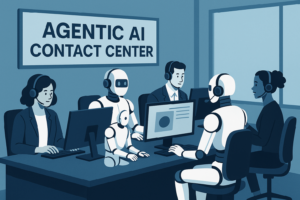Top Tips for a Winning Agentic AI Contact Center for 2025

The best options for deploying Agentic AI Contact Centers are to evaluate, test and use sample data to simulate a conversational experience prior to a decision. Agent AI can produce an Omnichannel on steroids which can propel you over your competition literally in days. If you are new to this topic listen on this Podcast discussing what Agentic AIs!
First, is your organization even ready yet for a Generative AI deployment? Building an AI Center of Excellence (COE) is something we recommend. It will document workflows, bring users and leadership under one plan and put down measurable outcomes.
Other areas IT leaders often overlook is their architecture and the ability to interact with an AI Contact Center. If you have a Tier-1 ISP to connect your environment such as an on-prem LLM build in your datacenter or cloud provider, the latency, capacity and cost will matter.
What are the Key Characteristics of Agentic AI Systems?
- Goal-oriented autonomy: Ability to independently determine steps needed to accomplish defined objectives
- Persistent memory and context: Maintaining relevant information across multiple interactions and tasks
- Tool use capabilities: Effectively leveraging external tools and APIs to extend functionality
- Self-improvement: Learning from past actions to refine future performance
- Planning and reasoning: Breaking down complex goals into manageable steps
- Resilience and adaptability: Handling unexpected scenarios and recovering from errors
- Human collaboration: Working effectively alongside human teammates
Agentic AI differs from simple automation by operating with higher-level objectives rather than rigid scripts, making dynamic decisions based on changing conditions and available resources
Top Tips to deploying Agentic AI for your Contact Center
Step #1: Define Your Agentic AI Requirements
What are you trying to solve with Agentic AI as it relates to your Contact Center. Have you thought about the very basics such as upskilling your current Agents? Will this deployment of AI make you more competitive over other organizations? Will Conversational AI allow you to reach more customers faster providing a better customer experience? These are some very basic questions you must answer first before you can deploy a solution. Often company jump into AI without a solid plan and overspend and tie up critical employee resources.
Step #2 Developing Your Agentic AI Architecture Design
The very basics of developing a winning architecture design for your Gen AI Contact Center must factor in:
- Foundation model selection considerations
- Agent framework design components
- Tool integration specifications – do you need APIs from other SaaS licenses?
- Human-AI collaboration interfaces – AI supervision is a must
- Deployment infrastructure requirements – speed and response are paramount for customers, where you deploy your agentic environment can make or break you.
- Does it have a KMP integration?
This phase also covers creating technical documentation and reference architecture diagrams to communicate your vision.
This detailed section explains how to structure your vendor solicitation package with several key components. Macronet Services has been working with clients on AI Contact Center RFPs to show an unbiased view of outcomes. Components include:
- A comprehensive RFP structure with several essential sections
- Key questions specifically designed to evaluate vendors’ agentic AI capabilities
- Focus areas for vendor evaluation include foundation model expertise, agent capabilities, and ethics.
- Terms & Conditions
- SLAs
- Pricing
- Pro Serve Implementation (if available)
- Support Team – Customer Success and other resources post-implementation
Step #4: Vendor Selection Process
In this step, the vendor selection process is narrowed to your final partners. Areas to consider with Agentic AI contact center selection should include
- Initial screening criteria
- Technical evaluation approaches & customer interaction
- Proof-of-concept testing recommendations – are you using real or test data?
- Reference validation strategies – what other customers have deployed this?
- Total cost of ownership analysis
Step #5 Implementation Planning
Finally, the guide covers establishing a solid foundation for implementation through joint planning and governance structures.
I’ve also included sections on common challenges (with mitigation strategies) and emerging trends to consider when designing agentic AI systems.
Would you like me to expand on any section of this guide or modify any aspect of it?
Emerging Trends to Consider with Agentic AI Contact Centers
As you design your agentic AI system, keep these emerging trends in mind:
Multi-Agent Systems
The trend toward multiple specialized agents working together to accomplish complex tasks:
- Specialized agents for different functions
- Collaborative problem-solving
- Hierarchical agent structures
- Agent-to-agent communication protocols
Local Deployment Options
Growing capabilities for on-premises or edge deployment:
- Smaller, more efficient models
- Reduced latency requirements
- Enhanced privacy and security
- Hybrid cloud/local architectures
Human-AI Teaming
Evolution of more sophisticated collaboration models:
- Adaptive automation levels
- Contextual handoffs between human and AI
- Shared mental models
- Team-based performance metrics
Multimodal Capabilities
Expansion beyond text to other modalities:
- Image recognition and generation
- Audio processing and generation
- Video analysis
- Mixed-media understanding